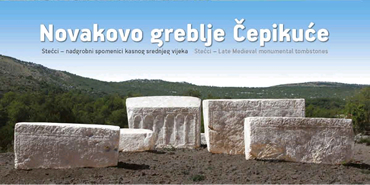Dubrovačko Primorje kroz povijest
Na području današnje Općine Dubrovačko primorje nisu do danas pronađeni ostatci neolitske provenijencije.
Možda će evidentirani lokalitet Špilja, smješten zapadno od naselja Đonta Doli, donijeti nove spoznaje. Prijelazno razdoblje iz kamenog (neolit) u metalno (brončano) doba obuhvaća prva dva stoljeća II. tisućljeća prije Krista.
To je razdoblje veikih migracija indoeuropskih naroda. Karakteristični su za sepulkralni ritus brončanog i željeznog doba grobni humci (tumuli). Na području Dubrovačkog primorja ima ih mnogo. Pokojnika pokapaju u zgrčenom položaju. Grobnu komoru oblikuju kamene ploče osovljene “na nož”, a zatvara je poklopnica. Iz željeznog doba kao i iz prethodnih razdoblja, nedovoljna istraženost otežava egzaktnije zaključivanje. Način života ilirskih plemena ničim se ne razlikuje od brončano dobnog stanovništva, od odabira staništa, njihove arhitekture (gradine), pa do konstrukcije grobnih humaka (tumula).
Na prostoru Dubrovačkog primorja evidentirano je mnoštvo gradina: Veliki Lukovac sjeverozapadno od naselja Topolo; Gradac iznad Ošlja; Sutvid sjeverozapadno od Smokovljana; Stara straža sjeverno od zaseoka Gornji Zaton; Gradina južno od naselja Trnova; Oštri Gradac iznad Slanoga; Gradina; Slano; Đuraševa gomila; zaseok Prdenići; Gornji Majkovi. U neposrednoj blizini tih gradinskih lokaliteta, evidentirano je mnoštvo tumula, primjerice Gomile-Imotica; Sokolova gruda-Topolo; Gomile-Ošlje; Mjenovići-Topolo; Rudine-Lisac; Gomile- Mravinca; Kuk-Majkovi. Stanovništvo naše regije pripada ilirskoj etničkoj zajednici koja se dijelila na nekoliko plemena, a naš su prostor nastavali Plereji (područje od Boke kotorske do Neretve). U III. st. prije Krista dolaze pod vlast Ardijejaca koji formiraju ilirsku državu od Vojuše u Albaniji pa sve do Neretve. U III. st. prije Krista kad su na vrhuncu svoje moći, sukobljavaju se s Rimom, a 135. g. prije Krista doživljavaju konačni poraz. Romanizacijom, Primorje je postalo ruralno područje provincije Dalmacije, a u administrativnoj podjeli pripadalo je ageru koloniji Naroni (Vid kod Metkovića).
Za vrijeme rimske dominacije, koja traje više od pola tisućljeća, baštinjeni su spomenici što ih je napredna rimska civilizacija inaugurirala na nekadašnjem ilirskom području. Materijalni ostatci antike prate se prema ostatcima ladanjsko-gospodarskih građevina villa rustica: Neljet grad - Imotica, Topolo i Slano. Gospodarska kriza Rimskog Carstva počinje u III. st., čemu pridonose provale Barbara potkraj IV. i V. st. koje uzrokuju česte administrativne promjene, do konačnog pada Zapadnog Rimskog Carstva 476. g. Nakon kratkotrajne vladavine Gota, Dalmacija je pod istočnorimskim carem Justinijanom 535. - 536. g. Ti povijesni procesi odredili su razvoj kasnoantičke kulturne baštine na koju je snažno utjecalo kršćanstvo.Najznačajniji je kasnoantički lokalitet na području Dubrovačkog primorja širi prostor oko Franjevačkog samostana u Slanom.
Apsida crkve sv. Martina na groblju u Čepikućama, nedavnim je istraživanjima, iščitana kao kasnoantička sakralna građevina. Tijekom VII. st. dolazi do znatnijih društveno-političkih promjena čije će se posljedice jače osjetiti na tom području. U velikoj seobi naroda, najvjerojatnije u prvoj polovici VII. st., uništena je gotovo većina kasnoantičkih gradova u Dalmaciji (Salona, Narona i Epi- daur). Postupno se uspostavlja suživot novopridošlih Hrvata i romanskih starosjedilaca. Na obali se učvršćuju srednjovjekovni gradovi komune pod patronatom Bizanta, a u njihovu se zaleđu formiraju nove državne zajednice. Jedna od njih je kneževina Zahumlje, kojoj je Ston od IX. st. glavna kneževska prijestolnica.
Predromanički spomenici sačuvani su u Topolome, Ošlju i Slanome. U Topolome u crkvi sv. Stjepa na sekundarno su iskorištene dvije kamene grede za crkveni portal. Poviše naselja Ošlje, na lokalitetu zvanom Bijela lokva, ostatci su ranosrednjovjekovne sakralne građevine, tzv. “Rotonda“. Nalazi kapitela i tranzene velikih dimenzija u Slanome, svakako govore kako su oni pripadali kamenoj opremi veće crkve. S pravom se može pretpostaviti da je starokršćanska sakralna građevina doživjela predromaničku adaptaciju, poput nekoliko crkava s dubrovačkog područja. Posljednjeg vladara Zahumlja, Ljutovita, 1042. godine porazio je dukljanski knez Vojislav, a Zahumlje pripojio Duklji. Sredinom XII. st. Zahumlje potpada pod rašku vlast, a u izvorima se počinje zvati Hum. Krajem XII. st. zavladao je hrvatski herceg Andrija, kasniji kralj hrvatsko-ugarske zajednice Andrija II. Od tada u Stonu stoluju kneževi i župani nastojeći voditi samostalnu politiku. Na prijelazu XIII.u XIV. st. Bosnom i Humom vladao je hrvatski ban Pavao Bribirski. Nakon što je njegov drugi sin Mladen II. izgubio 1322. bansku čast, nekoliko godina nakon toga, bosanske i dubrovačke čete osvajaju i humsko područje. Dubrovčani 1333. godine uz pomoć bosanskog bana Stjepana Kotromanjića i Raške, kupnjom Stona s Pelješcem, postaju vrlo zainteresirani za stjecanje Dubrovačkog primorja, zbog sigurnosti trgovine koja je prolazila prema Zavali i Gabeli.
Nakon poraza u sukobu s ugarsko-hrvatskim kraljem Ludovikom I., Venecija se mirom u Zadru (1358.) morala odreći cijele istočne obale Jadrana. Tada se Dubrovnik jedini od hrvatskih priobalnih gradova, trajno oslobađa mletačke dominacije. Godina 1358. prijelomna je u dubrovačkoj povijesti. Višegradskim ugovorom s Ludovikom I., sklopljenim 27. svibnja 1358., Dubrovnik je stekao zaštitu ugarskohrvatske krune i postao dijelom Kraljevstva Dalmacije i Hrvatske. U novom državnopravnom okviru, Dubrovnik je stekao punu političku samostalnost koju je uspio zadržati i nakon sloma Ugarsko-hrvatske države 1526. godine. Stekavši sva obilježja državnosti: teritorij, grb, zastavu i vlastiti monetarni sustav, dubrovačka se komuna od sredine XIV. st. počinje nazivati Republikom (Respublica Ragusina). Nakon smrti Tvrtka I., 1391. godine, u Bosanskoj državi nastaje rasulo. Diplomatskim aktivnostima kojima su prethodila vojna, Dubrovačka Republika 1399. go- dine od kralja Ostoje otkupljuje područje Dubrovačkog primorja koji se u povijesnim vrelima od tada najčešće susreće pod nazivom Terra nova. Kasno srednjovjekovno raz- doblje obilježeno je nekropolama stećaka: Topolo, Bistrina Stupa, Čepikuće i dr. Od sakralnih građevina, crkva sv. Jeronima i sv. Petra u Slanomu; sv. Ane u Podimoču; sv. Frana u Majkovima i dr. Neke su od tih crkvica barokizirane, ali zbog trusnosti područja mnoge susakralne građevine izbrisane s karte prethodnih razdoblja, kao što je i neke zadnji potres u Primorju, gotovo do temelja srušio.
Tijekom XIX. st. Dubrovačko primorje, kao i ostala područja Dubrovačke Republike, proživljava iste povijesne korjenite promjene. Francuzi pod vodstvom maršala Marmonta 1806. godine osvajaju Dubrovnik, a nepune dvije godine kasnije ukidaju Dubrovačku Republiku i uključuju je u Kraljevinu Iliriju. Nakon turbulentnih vremena ruske i crnogorske opsade dubrovačkog područja te Napoleonova poraza, Dubrovčani su pokušali ponovno uspostaviti Republiku. Međutim, mirovnim sporazumom Bečkog kongresa 1815. godine, Dubrovnik dolazi pod vlast Austrije. Nakon poraza Austro-Ugarske Monarhije i njezina raspada 1918. godine, stvara se Jugoslavija koja, u različitim inačicama, traje do lipnja 1991. god kad je utemeljena neovisna Republika Hrvatska. Bezrazložno je jugoslavenska armija, uz potporu srpskih i crnogorskih dobrovoljaca, 1. listopada iste godine napala Dubrovačko primorje, rušila ga, ubijala, razarala njihove kuće, vinograde i maslinike, palila i pljačkala. Međutim, ništa nije moglo uništiti prkos i ponos ljudi ovoga kraja koji su se vratili, strpljivo gradili, obnovili svoje kuće, nastavili čuvati baštinu i njegovati zemlju.








